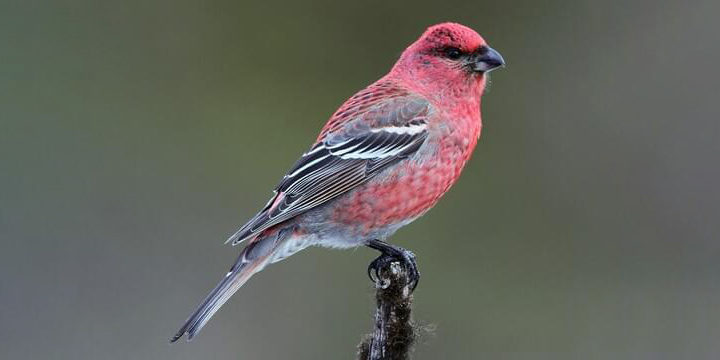Bird of The Week: Pine Grosbeak
Scientific Name: Pinicola enucleator
Population: 11 million world; 5.5 million North America
Trend: Decreasing
Habitat: Boreal forests
About
The Pine Grosbeak is the largest of northern finches, about the size of an American Robin. Less common than other boreal finch species such as the Pine Siskin, it is a striking sight when it appears perched among snow-covered branches. The male Pine Grosbeak has a rose-red body and rump, set off by dark wings with two white wing bars. Females are duller but still colorful, with mustard-yellow and gray in a similar pattern (although some females, as well as young males, show rust-orange instead of yellow). This boreal bird’s genus name Pinicola combines the Latin words for “pine tree” and “dwell.” Its species name enucleator means “to remove the kernel,” acknowledging the Pine Grosbeak’s skill at extracting kernels from seeds and fleshy fruits with its stubby, almost parrot-like bill.
A Mopey Misnomer
Since the Pine Grosbeak often lives far from humans, it tends to be rather tame, often allowing observers to approach closely. This lack of fear, coupled with its slow-moving, almost sluggish ways, led the residents of Newfoundland to nickname this bird the “mope.”
Songs and Sounds
The song of the Pine Grosbeak, performed mostly by the male, is a series of flute-like, varied, musical warbles. The call, given by both sexes, is a whistled “tee-tee-tew,” frequently heard in flight.
Breeding and Feeding
Providers of Paste
The Pine Grosbeak is monogamous, forming pairs each spring. The male defends his territory by singing from high in the treetops, and courts his mate by feeding her tidbits of food.
Once mated, the female gets to work building a bulky, cup-shaped nest of twigs, rootlets, and other vegetation. The nest is well-hidden in the foliage of a coniferous tree or a shrub, usually at a height below 12 feet. The female lays two to five eggs, incubating them herself for around two weeks. The male often brings her food while she broods. After the eggs hatch, both parents pitch in to feed the chicks with a paste of insects and plant material that they regurgitate from specialized cheek pouches.
Young Pine Grosbeaks are ready to leave the nest around two weeks after hatching, but they still depend on adults for food for almost another month. This species produces only one brood per season.
Frugivorous Finch
Much of the year, the Pine Grosbeak primarily eats plant matter, including fruits, seeds, buds, and needles. Favored trees include mountain ash (rowan), crabapple, spruce, juniper, birch, and maple. In the summer, particularly while feeding young, this bird adds insects and spiders to its diet.
In the winter, Pine Grosbeaks can be found in small groups foraging for grit and salt along roadsides. They also visit backyard feeders for sunflower seeds and suet, often in the company of Black-capped Chickadees and Blue Jays. Take a peek at the Cornell Lab of Ornithology’s Ontario FeederWatch Cam to watch Pine Grosbeaks visiting a feeder.
Region and Range
Pine Grosbeak range map by ABC.
The Pine Grosbeak is a permanent resident of boreal forests in North America and across northern Eurasia. Nine subspecies are recognized across this wide range, with marked differences in bill and body size and wing and tail length. Although Pine Grosbeaks are resident in many places, in others, populations make seasonal movements depending on food availability. When food is unusually scarce, this species may wander great distances south. Such seasonal movements in search of food, called irruptions, are also noted in other northern bird species ranging from Snowy Owls to Evening Grosbeaks.
Conservation
Northern Exposures
Although the Pine Grosbeak is widespread and breeds far from most human activity, it still faces loss of its boreal forest habitat due to the effects of climate change and unsustainable logging. Collisions with cars may kill Pine Grosbeaks during the winter, since they come to roadsides to feed on salt and grit.
Get Involved
Policies enacted by the U.S. Congress and federal agencies, such as the U.S. Fish and Wildlife Service, have a huge impact on migratory birds. You can help shape these rules for the better by urging lawmakers to prioritize birds, bird habitat, and bird-friendly measures. To get started, visit ABC’s Action Center.
Living a bird-friendly life can have an immediate impact on migratory birds in the United States. Doing so can be as easy as adding native plants to your garden, avoiding pesticides, and keeping cats indoors. To learn more, visit our Bird-Friendly Life page.
American Bird Conservancy and our Migratory Bird Joint Venture partners have improved conservation management on more than 8.5 million acres of U.S. bird habitat — an area larger than the state of Maryland — over the last ten years. That’s not all: With the help of international partners, we’ve established a network of more than 100 areas of priority bird habitat across the Americas, helping to ensure that birds’ needs are met during all stages of their lifecycles. These are monumental undertakings, requiring the support of many, and you can help by making a gift today.
Source: American Bird Conservancy (abcbirds.org)


